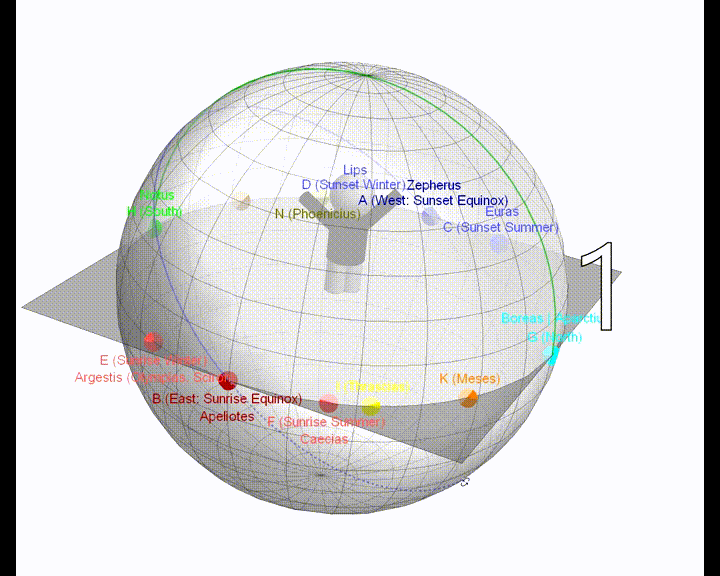
Climate, Weather and Health
History meets Science
Meteorology Beyond Borders
Wind
Wind has many terms in antiquity: The direct translation to Latin would be
-
ventus, -i
but Aristotle uses two different terms with slightly different meanings:
Aristotle states that winds are blowing from various directions and with different qualities.
He defines the directions by using the rising and setting points of the Sun along the horizon, e.g.: the west wind blows from the direction where the Sun sets at the equinoxes.
This figure presents the kinds of winds according to Aristotle with an astronomical reference.
Modern Description

Wind is a motion of air. Air always moves from a place of higher air pressure to a place of lower air pressure. The cause for higher air pressure can be a higher temperature which can be caused by the sun. As the amount of sunshine (duration of daylight and warmth) depends on the season, predominant wind directions are (at least partially) connected to the seasons. In modern geoscience, this can be understood through the concept of the tropical wind circulation. Although lacking knowledge about the causes of the seasonal winds, ancient scholars already noticed them as a natural phenomenon. For them, it was striking that typical seasonal winds always occur simultaneously with the heliacal rising of the same stars or constellations or always when the full moon or crescent moon stands in a specific constellation.
From ancient Mesopotamia, the earliest astronomical compendium, MUL.APIN, dating to the later half of the second millennium BCE. In its second part, lists of predominant wind directions with typical seasons are given.
While the centre of the tropical wind system shifts from the southern to the northern tropics and back during the course of the year, the northern and southern circulation cells follow this motion accordingly. In the northern summer, the inter tropical convergence zone lies roughly at the northern tropic and the northern cell of the trade wind system lies above the Mediterranean. This causes a rather stable trade wind in the Aegean Sea which is also influenced by a local monsoon effect (i.e. the gradient of air pressure above land and sea) and is therefore called Etesian Wind.
Etesian Wind
-
etesiai,-arum (Luc, Sen)
The Etesian winds blow from north to south in the Aegean Sea in summer. They are a secondary effect of the northern position of the intertropical convergence zone because they emerge in the geographical area where the Asian monsoon Low and the Azores High meet. As the two areas rotate in opposite directions, there are strong winds from north to south in the intersection.

Etesian
Why wind directions
depend on seasons
The tropical wind system is caused by the sun, therefore it depends on the changing seasons. In the region above which the Sun stands in zenith, the ground is heated up most, hot air rises and a center of a low pressure area is formed.
Around the equinoxes, the Sun stands in zenith at the equator region but around the solstices, the Sun is above the tropical circles. Therefore, the tropical wind system shifts between the northern and southern tropical circle.
In northern summer, the northern half of the tropical wind system reaches north as far as the Mediterranean which also finds its expression in the Azores high. This anticyclone meets the cyclones of the Asian monsoon area above Asia Minor.
The appearances of stars after invisibility "behind" the Sun does not create or bring the seasonal climate but it always occurs simultaneously.

left:
Sun in Aries
Sun in Libra
right:
Sun in Cancer
Earth
northern summer solstice

Whirlwind
A special sort of wind is a movement of air in spiral trajectories. This sort of whirl of air can transport grains of sand and dust or water drops.
